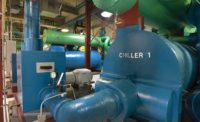Nearly 20 years ago, the U.S. Green Building Council (USGBC) introduced the Leadership in Energy and Environmental Design, or LEED, rating system. The emergence of LEED helped define what it means to be a green building, and today there are more than 96,275 registered and certified buildings and spaces around the world. LEED has become the de facto leadership standard for green buildings, and, throughout its evolution, has emphasized continuous improvement. The latest version, LEED v4.1, raises the bar once more for the industry with a series of updates that prioritize ongoing building performance monitoring.
LEED has been adopted across industries and sectors, from commercial buildings to health care spaces and schools. There are more than 2,100 K-12 spaces and more than 4,600 higher education spaces certified globally. LEED’s flexibility and applicability to virtually all space types have enabled the rating system to support leaders who are creating healthier and more sustainable spaces for people.
Recently, USGBC announced the Top 10 States for LEED, recognizing states with the greatest amount of newly certified square feet per person in 2018. Home to more than 128 million Americans, these states collectively certified more than 468 million gross square feet of space. Illinois took the top spot with more than 5.31 square feet of LEED space per person added in 2018. Washington and Texas also returned to the list securing the highest rankings in each states’ history at Nos. 3 and 5, respectively.
All told, 1,826 LEED-certified buildings in 2018, from offices and animal welfare spaces to hospitals, were represented across the top 10 states. Included in that mix were several standout K-12 schools, demonstrating how green building is not only creating more efficient spaces for students, faculty, and staff but is also providing a teaching tool for classrooms.
Massachusetts has consistently been a top contender when it comes to LEED. This year “The Bay State” came in second as a Top 10 State for LEED thanks to projects like the LEED Platinum Dr. Martin Luther King, Jr. School in Cambridge. The school is a new construction project built on the site of a former school campus that was fraught with challenges. The K-12 school became a prototype for the Cambridge Green Schools Initiative and changed the way the district approached energy in all of its buildings. The design goal was to synthesize the Cambridge Public Schools Superintendent’s “Innovation Agenda,” targeting significantly enhanced educational outcomes within the urban district with the mayor’s desire to pursue net zero energy. Together, these goals inspired a sustainable, high-performance urban learning environment for its students and the community.
Throughout the building, learning flows seamlessly from indoors to outdoors, with terraces and rooftop gardens providing access to the outdoors on every floor. Promoting activity was important in this multistory school. Stairwells in each quadrant represent a seasonal tree through custom perforated aluminum panels that shade the exterior glazing featuring a biophilic pattern.
Daylight without glare in the learning spaces and corridors contributes to the healthy learning environment. Classroom windows allow appropriate distribution and control of daylight through exterior and interior light shelves and sun shades. Care was taken to not over daylight spaces, limiting the glazing ratio to 31.7 percent overall and reducing the glazing on the west façade of corner classrooms to 9 percent. Actual measurements of classroom spaces found more area with usable daylighting levels than modeling predicted. The school also includes 65 ground-source heat pump wells 525 feet deep to support heating and cooling systems. There is also signage around the building and views into the building’s wall systems and mechanical room to enhance students’ understanding of and relationship to energy.
The success of the Dr. Martin Luther King Jr. School has led to new district-wide policies in Cambridge around plug loads, maintenance, and waste. Succinctly summarizing the results, one teacher remarked, “My life is better because I teach in this building.”
In Texas, which ranked No. 5 among the Top 10 States, LEED Silver Milby High School is one of the first high schools in Houston, originally built in 1926. Historic preservation was of utmost importance. The 1926 façade and structure, along with 40,000 square feet of the original school floor area, were preserved. This strategy reduced the environmental impacts of the project by extending the life of the materials used and serves to illustrate construction methods used to keep people comfortable in the era before air conditioning. The original 11-foot windows, restored to their former glory, were once used to maximize cross-ventilation by increasing the building surface exposed to breezes. The restrictive budget led to minimalist, meaningful, sustainable interiors featuring exposed brick and a concrete structure. The exposed bones and veins of the structure also serve a pedagogical function, teaching students about the systems that make the building work.
A post-occupancy evaluation was conducted after one year that included on-site measurements, surveying of students, interviews with teachers and staff, and analysis of utility bills. The on-site assessment included thermal camera images to evaluate envelope performance and measurements of the following: daylight illuminance, solar radiation transferred through glazing, soil temperatures in landscaped areas, CO2 levels, particulate matter (PM10 and PM2.5), and formaldehyde. Student surveys included questions related to thermal comfort, indoor air quality, acoustics, daylight and views, transportation to/from campus, wayfinding, pedagogy, and aspects of the design. Teachers and administrative staff were interviewed in person on similar topics as well as student conduct and performance relative to the old school.
Among the major lessons learned was the success of daylighting and the design intent of transparency within the school. The amount of exterior and interior glass increased light penetration and was perceived to reduce disciplinary issues due to greater visibility. Indoor air quality was both observed and reported to be outstanding. Overall satisfaction with the school was high, and the preservation of the original 1926 building and its homage to the history of the school was identified as particularly significant and appreciated.
LEED has always been focused on strong environmental performance, which leads to economic prosperity, better quality of life, and improved human health and wellbeing for all. From new construction to interior spaces and existing buildings, schools can put people and performance at the heart of their spaces and the communities they create. Registration for the latest version of LEED is currently open. For more information, visit https://new.usgbc.org/leed.




